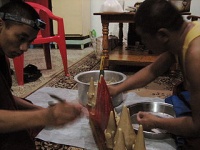Torma
Aus Spiritwiki
Version vom 6. November 2013, 14:11 Uhr von Adm1 (Diskussion | Beiträge)
Torma (Skt: Balingta, Tib: Tor-ma, Wylie: gtor ma) sind Figuren, die zumeist aus vielfarbigen Blumen und Butter bestehen. Sie werden in Vajrayana - Ritualen verwendet.
Für den Träger des Torma werden zumeist weisse oder rote farben verwendet.
They are made in specific shapes based on their purpose, usually conical in form.
Bei Festen wird ein sehr großes Torma zubereitet.
Varianten
Tormas können verschiedensten Zwecken dienen
- Deity tormas (Wylie: rten gtor) repräsentieren eine bestimmte tantrische Gottheitwie Tara oder Avalokiteshvara, to very complex designs for semi-wrathful deities like Vajrayogini and Chakrasamvara.[11]
- Nahrungstormas
- Offering tormas may be made for and offered to deities (Wylie: sgrub gtor / mchod gtor), to Dharma Protectors, to obstructing spirits, or to other lower beings. Torma for obstructing spirits are called gektor.[
- A torma may be used in Tibetan medicine to extract an illness from a patient as a cure. The torma is then cast away.[13]
- A captured torma (Wylie: gta' gtor) may be used to speed completion of activities, by planning to offer the torma at the completion of the activity thereby encouraging successful activity.[5]
Literatur
- Beer, Robert (2003) The Handbook of Tibetan Buddhist Symbols ISBN 1-932476-03-2
- Kongtrul, Jamgon and Padmasambhava : Light of Wisdom: A Collection of Padmasambhava's Advice to the Dakini ; Translated by Erik Pema Kunsang (1998) , Yeshe Rangjung Yeshe Publications, ISBN 962-7341-33-9
Weblinks
- en Wiki zum Torma
